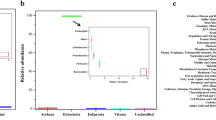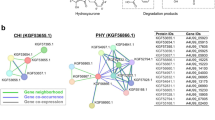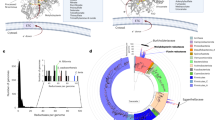Abstract
Plant-derived lignans, consumed daily by most individuals, are thought to protect against cancer and other diseases1; however, their bioactivity requires gut bacterial conversion to enterolignans2. Here, we dissect a four-species bacterial consortium sufficient for all five reactions in this pathway. A single enzyme (benzyl ether reductase, encoded by the gene ber) was sufficient for the first two biotransformations, variable between strains of Eggerthella lenta, critical for enterolignan production in gnotobiotic mice and unique to Coriobacteriia. Transcriptional profiling (RNA sequencing) independently identified ber and genomic loci upregulated by each of the remaining substrates. Despite their low abundance in gut microbiomes and restricted phylogenetic range, all of the identified genes were detectable in the distal gut microbiomes of most individuals living in northern California. Together, these results emphasize the importance of considering strain-level variations and bacterial co-occurrence to gain a mechanistic understanding of the bioactivation of plant secondary metabolites by the human gut microbiome.
This is a preview of subscription content, access via your institution
Access options
Access Nature and 54 other Nature Portfolio journals
Get Nature+, our best-value online-access subscription
$29.99 / 30 days
cancel any time
Subscribe to this journal
Receive 12 digital issues and online access to articles
$119.00 per year
only $9.92 per issue
Buy this article
- Purchase on Springer Link
- Instant access to full article PDF
Prices may be subject to local taxes which are calculated during checkout




Similar content being viewed by others
Data availability
16S ribosomal DNA and RNA sequencing data have been deposited in the NCBI Sequence Read Archive under BioProject accession numbers PRJNA450120 and PRJNA412637. Figure source data and additional study data are available on request from the corresponding author.
References
Adlercreutz, H. Lignans and human health. Crit. Rev. Clin. Lab. Sci. 44, 483–525 (2007).
Clavel, T., Doré, J. & Blaut, M. Bioavailability of lignans in human subjects. Nutr. Res. Rev. 19, 187–196 (2006).
Spanogiannopoulos, P., Bess, E. N., Carmody, R. N. & Turnbaugh, P. J. The microbial pharmacists within us: a metagenomic view of xenobiotic metabolism. Nat. Rev. Microbiol. 14, 273–287 (2016).
Carmody, R. N. & Turnbaugh, P. J. Host–microbial interactions in the metabolism of therapeutic and diet-derived xenobiotics. J. Clin. Invest. 124, 4173–4181 (2014).
Koppel, N., Maini Rekdal, V. & Balskus, E. P. Chemical transformation of xenobiotics by the human gut microbiota. Science 356, eaag2770 (2017).
Valsta, L. M. et al. Phyto-oestrogen database of foods and average intake in Finland. Br. J. Nutr. 89, S31–S38 (2011).
Woting, A., Clavel, T., Loh, G. & Blaut, M. Bacterial transformation of dietary lignans in gnotobiotic rats. FEMS Microbiol. Ecol. 72, 507–514 (2010).
Clavel, T. & Mapesa, J. O. in Natural Products: Phytochemistry, Botany and Metabolism of Alkaloids, Phenolics and Terpenes (eds Ramawat, K. G. & Mérillon, J.-M.) 2433–2463 (Springer, 2013).
Olsen, A. et al. Plasma enterolactone and breast cancer incidence by estrogen receptor status. Cancer Epidemiol. Biomarkers Prev. 13, 2084–2089 (2004).
Sonestedt, E. et al. Enterolactone is differently associated with estrogen receptor β-negative and -positive breast cancer in a Swedish nested case-control study. Cancer Epidemiol. Biomarkers Prev. 17, 3241–3251 (2008).
Seibold, P. et al. Enterolactone concentrations and prognosis after postmenopausal breast cancer: assessment of effect modification and meta-analysis. Int. J. Cancer 135, 923–933 (2014).
Mabrok, H. B. et al. Lignan transformation by gut bacteria lowers tumor burden in a gnotobiotic rat model of breast cancer. Carcinogenesis 33, 203–208 (2012).
Saarinen, N. M. et al. Enterolactone inhibits the growth of 7,12-dimethylbenz(a) anthracene-induced mammary carcinomas in the rat. Mol. Cancer Ther. 1, 869–876 (2002).
Zaineddin, A. K. et al. Serum enterolactone and postmenopausal breast cancer risk by estrogen, progesterone and herceptin 2 receptor status. Int. J. Cancer 130, 1401–1410 (2012).
Stitch, S. R. et al. Excretion, isolation and structure of a new phenolic constituent of female urine. Nature 287, 738–740 (1980).
Setchell, K. D. R. et al. Lignans in man and in animal species. Nature 287, 740–742 (1980).
Clavel, T. et al. Intestinal bacterial communities that produce active estrogen-like compounds enterodiol and enterolactone in humans. Appl. Environ. Microbiol. 71, 6077–6085 (2005).
Clavel, T., Borrmann, D., Braune, A., Doré, J. & Blaut, M. Occurrence and activity of human intestinal bacteria involved in the conversion of dietary lignans. Anaerobe 12, 140–147 (2006).
Wang, L.-Q., Meselhy, M. R., Li, Y., Qin, G.-W. & Hattori, M. Human intestinal bacteria capable of transforming secoisolariciresinol diglucoside to mammalian lignans, enterodiol and enterolactone. Chem. Pharm. Bull. 48, 1606–1610 (2000).
Clavel, T., Henderson, G., Engst, W., Doré, J. & Blaut, M. Phylogeny of human intestinal bacteria that activate the dietary lignan secoisolariciresinol diglucoside. FEMS Microbiol. Ecol. 55, 471–478 (2006).
Bisanz, J. E. et al. Illuminating the microbiome’s dark matter: a functional genomic toolkit for the study of human gut Actinobacteria. Preprint at https://www.biorxiv.org/content/10.1101/304840v1 (2018).
Haiser, H. J. et al. Predicting and manipulating cardiac drug inactivation by the human gut bacterium Eggerthella lenta. Science 341, 295–298 (2013).
Koppel, N., Bisanz, J. E., Pandelia, M.-E., Turnbaugh, P. J. & Balskus, E. P. Discovery and characterization of a prevalent human gut bacterial enzyme sufficient for the inactivation of a family of plant toxins. eLife 7, e33953 (2018).
Maini Rekdal, V., Bess, E. N., Bisanz, J. E., Turnbaugh, P. J. & Balskus, E. P. Discovery and inhibition of an interspecies gut bacterial pathway for levodopa metabolism. Science 364, eaau6323 (2019).
Davis, R. M., Muller, R. Y. & Haynes, K. A. Can the natural diversity of quorum-sensing advance synthetic biology? Front. Bioeng. Biotechnol. 3, 30 (2015).
Rohman, A., van Oosterwijk, N., Thunnissen, A.-M. W. H. & Dijkstra, B. W. Crystal structure and site-directed mutagenesis of 3-ketosteroid Δ1-dehydrogenase from Rhodococcus erythropolis SQ1 explain its catalytic mechanism. J. Biol. Chem. 288, 35559–35568 (2013).
Fukuhara, Y. et al. Discovery of pinoresinol reductase genes in sphingomonads. Enzyme Microb. Technol. 52, 38–43 (2013).
Maier, L. et al. Extensive impact of non-antibiotic drugs on human gut bacteria. Nature 555, 623–628 (2018).
Milder, I. E. J. et al. Intake of the plant lignans secoisolariciresinol, matairesinol, lariciresinol, and pinoresinol in Dutch men and women. J. Nutr. 135, 1202–1207 (2005).
Matthews, R. G. Cobalamin- and corrinoid-dependent enzymes. Met. Ions Life Sci. 6, 53–114 (2009).
Hille, R. The molybdenum oxotransferases and related enzymes. Dalton Trans. J. Inorg. Chem. 42, 3029–3042 (2013).
Nayfach, S., Fischbach, M. A. & Pollard, K. S. MetaQuery: a web server for rapid annotation and quantitative analysis of specific genes in the human gut microbiome. Bioinformatics 31, 3368–3370 (2015).
Nayfach, S., Shi, Z. J., Seshadri, R., Pollard, K. S. & Kyrpides, N. C. New insights from uncultivated genomes of the global human gut microbiome. Nature 568, 505–510 (2019).
Alba, D. L. et al. Subcutaneous fat fibrosis links obesity to insulin resistance in Chinese-Americans. J. Clin. Endocrinol. Metab. 103, 3194–3204 (2018).
Anders, S. & Huber, W. Differential expression analysis for sequence count data. Genome Biol. 11, R106 (2010).
Langmead, B. & Salzberg, S. L. Fast gapped-read alignment with Bowtie 2. Nat. Methods 9, 357–359 (2012).
Anders, S., Pyl, P. T. & Huber, W. HTSeq—a Python framework to work with high-throughput sequencing data. Bioinformatics 31, 166–169 (2015).
Tang, H. & Mayersohn, M. Porcine prediction of pharmacokinetic parameters in people: a pig in a poke? Drug Metab. Dispos. 46, 1712–1724 (2018).
Bolvig, A. K., Adlercreutz, H., Theil, P. K., Jørgensen, H. & Bach Knudsen, K. E. Absorption of plant lignans from cereals in an experimental pig model. Br. J. Nutr. 115, 1711–1720 (2016).
Gohl, D. M. et al. Systematic improvement of amplicon marker gene methods for increased accuracy in microbiome studies. Nat. Biotechnol. 34, 942–949 (2016).
Callahan, B. J. et al. DADA2: high-resolution sample inference from Illumina amplicon data. Nat. Methods 13, 581–583 (2016).
Franke, A. A. et al. Liquid chromatographic–photodiode array mass spectrometric analysis of dietary phytoestrogens from human urine and blood. J. Chromatogr. B 777, 45–59 (2002).
Franke, A. A., Halm, B. M., Kakazu, K., Li, X. & Custer, L. J. Phytoestrogenic isoflavonoids in epidemiologic and clinical research. Drug Test. Anal. 1, 14–21 (2009).
Begum, A. N. et al. Dietary lignins are precursors of mammalian lignans in rats. J. Nutr. 134, 120–127 (2004).
Yu, G., Smith, D. K., Zhu, H., Guan, Y. & Lam, T. T.-Y. ggtree: an R package for visualization and annotation of phylogenetic trees with their covariates and other associated data. Methods Ecol. Evol. 8, 28–36 (2017).
Acknowledgements
The authors thank E. Balskus, A. Patterson and K. Pollard for comments on the manuscript. We are indebted to M. Blaut for providing E. lenta SECO-Mt75m2, L. Ortiz de Ora for assistance with generating the control construct for Edl expression, F. Grun, K. Torii and L. Custer for technical assistance with the mass spectrometry assays, and Separation Research (Turku, Finland) for donating chemicals. This work was supported by the National Institutes of Health (R01HL122593 and R21CA227232), Searle Scholars Program (SSP-2016-1352) and University of California, Irvine, Department of Chemistry. P.J.T. is a Chan Zuckerberg Biohub investigator and Nadia’s Gift Foundation Innovator, supported in part by the Damon Runyon Cancer Research Foundation (DRR-42-16). Fellowship support was provided by the Natural Sciences and Engineering Research Council of Canada (to J.E.B.), Canadian Institutes of Health and Research (to P.S.), Agency for Technology, Science and Research (to Q.Y.A.), and Life Sciences Research Foundation and Howard Hughes Medical Institute (to E.N.B.).
Author information
Authors and Affiliations
Contributions
E.N.B. performed or supervised all of the experimental work. J.E.B. performed the bioinformatics analyses and a subset of the experimental work. S.N. developed the metagenome database. P.S. assisted with bacterial culturing and heterologous expression. F.Y. and A.B. designed and implemented the culture-independent assays for gene prevalence. F.Y. performed the ex vivo incubations. E.W. generated the bacterial mutants. B.E.R. performed mass spectrometry on the bacterial cultures. X.L. and A.A.F. performed mass spectrometry on the mouse samples. Q.Y.A. extracted DNA from the human samples collected by D.L.A. and S.K.K. S.K. and D.W.W. synthesized dmSECO. P.J.T. supervised the study.
Corresponding author
Ethics declarations
Competing interests
P.J.T. is on scientific advisory boards for Kaleido, Pendulum, Seres and SNIPR Biome. There is no direct overlap between the current study and these consulting duties. All of the other authors declare no competing interests.
Additional information
Publisher’s note Springer Nature remains neutral with regard to jurisdictional claims in published maps and institutional affiliations.
Extended data
Extended Data Fig. 1 A four-member gut bacterial consortium is capable of converting dietary lignans to phytoestrogenic enterolignans.
a, Time-course experiments exhibiting the conversion of PINO to ENL and the growth profile of each bacterium with the lignan it metabolizes. Due to the chemical instability of dmSECO, this compound could not be accurately measured. Red arrows indicate time at which culture was exposed to lignan. Lignan concentrations were measured by HPLC. Culture turbidity, measured as optical density at 600 nm (OD600), is plotted. Values are mean±SEM (n=3 biological replicates). b, Growth profiles of each bacterium cultured with and without lignan. Culture turbidity, measured as optical density at 600 nm (OD600), is plotted. Values are mean±SEM (n=3 biological replicates).
Extended Data Fig. 2 PINO-metabolizing Coriobacteriia strains cannot be predicted based on phylogeny.
Phylophlan-based phylogenetic tree produced using ElenMatchR: Comparative Genomics Tool v0.321. This tree demonstrates the non-monophyletic nature of PINO metabolism across the strain collection and suggests that this phenotypic trait is decoupled from bacterial evolutionary history, suggesting the repeated gain or loss of the genes responsible.
Extended Data Fig. 3 Domain maps for gut bacterial genes implicated in the lignan metabolism pathway.
Annotations, assigned by homology, of the domains that constitute the putative lignan-metabolizing enzymes are presented and provide support for the inferred biochemical functions. All proteins are predicted to be cytoplasmic with the exception of Ber, which has an N-terminal TAT signal sequence, targeting Ber for secretion.
Extended Data Fig. 4 Colonization and PINO levels for gnotobiotic mice dosed with PINO-diGlc.
a, Relative abundance of bacterial genera for each of the strains used to colonize mice, as measured by 16S rRNA gene sequencing. b-c, Lignan levels in mice dosed with PINO-diglucoside (20 mg/kg) measured by Orbitrap mass spectrometry. Bars are mean±SEM (n = 5 biologically independent samples/colonization group, except in the ileum samples where ber+ n=4 biologically independent samples). Kruskal-Wallis with Dunn’s multiple comparisons test: *p<0.05. ns: not significant. ber+ and ber−: germ-free mice colonized with E. lenta DSM2243T (ber+ group) or E. lenta 1-3-56 (ber− group) and B. producta DSM3507, G. pamelaeae 3C, and L. longoviformis DSM17459T; mice dosed with PINO-diglucoside were also colonized with C. saccharogumia DSM17460T. GF: germ-free mice.
Extended Data Fig. 5 The putative enzymes mediating bacterial metabolism of dietary lignans.
A working model of the bacterial lignan metabolism pathway is presented. Several transporters, which traffic small molecules (ABC transporters) or ions (MFS transporters) across bacterial membranes, were significantly up-regulated in response to lignan doses and may be responsible for funneling substrates or products across cell membranes. Ber: benzyl ether reductase; Glm: guaiacol lignan methyltransferase; Cldh: catechol lignan dehydroxylase; Edl: enterodiol lactonizing enzyme; ABC: ATP-binding cassette; MFS: major facilitator superfamily.
Supplementary information
Rights and permissions
About this article
Cite this article
Bess, E.N., Bisanz, J.E., Yarza, F. et al. Genetic basis for the cooperative bioactivation of plant lignans by Eggerthella lenta and other human gut bacteria. Nat Microbiol 5, 56–66 (2020). https://doi.org/10.1038/s41564-019-0596-1
Received:
Accepted:
Published:
Issue Date:
DOI: https://doi.org/10.1038/s41564-019-0596-1
This article is cited by
-
Dietary- and host-derived metabolites are used by diverse gut bacteria for anaerobic respiration
Nature Microbiology (2024)
-
Engraftment of essential functions through multiple fecal microbiota transplants in chronic antibiotic-resistant pouchitis—a case study using metatranscriptomics
Microbiome (2023)
-
Dietary lignans, plasma enterolactone levels, and metabolic risk in men: exploring the role of the gut microbiome
BMC Microbiology (2022)
-
Distinct colon mucosa microbiomes associated with tubular adenomas and serrated polyps
npj Biofilms and Microbiomes (2022)
-
Genetic manipulation of the human gut bacterium Eggerthella lenta reveals a widespread family of transcriptional regulators
Nature Communications (2022)



